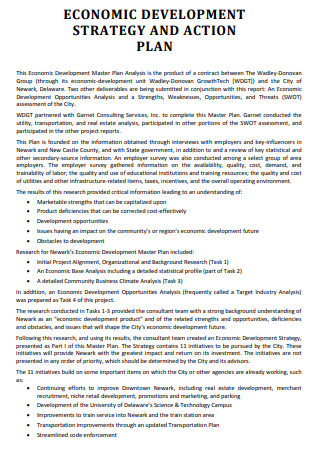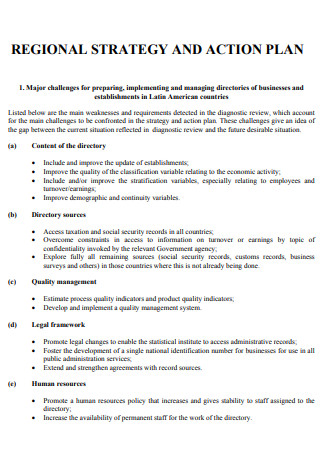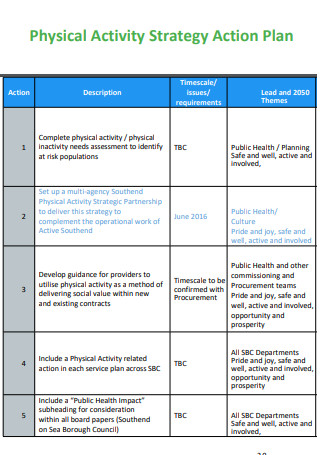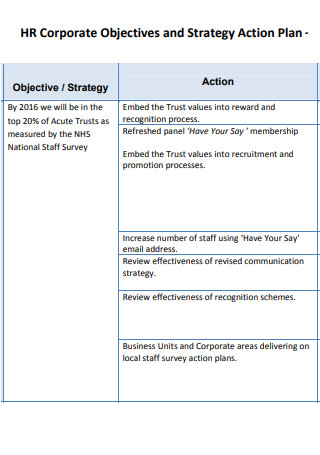50+ SAMPLE Strategy Action Plan
-

Metropolis Strategy Action Plan
download now -

Strategy Action Plan Work Sheet
download now -

Strategy Action Plan Alignment
download now -

Committee Strategy Action Plan
download now -

Strategy Action Plan
download now -

Data Strategy Action Plan
download now -

Transnational Strategy Action Plan
download now -

Global Strategy Action Plan
download now -

Medium Enterprises Strategy Action Plan
download now -

Formulating Strategy Action Plan
download now -

Economic Development Strategy Action Plan
download now -

Risk Management Strategy Action Plan
download now -

Management Response Strategy Action Plan
download now -

National Biodiversity Strategy Action Plan
download now -

Introductory Strategy Action Plan
download now -

Strategy Action Plan Checklist
download now -

Economic Strategy Action Plan
download now -

Biodiversity Strategy Action Plan
download now -

Accessibility Strategy Action Plan
download now -

Geospatial Strategic Action Plan
download now -

People Strategic Action Plan
download now -

Regional Strategic Action Plan
download now -

Programme Strategic Action Plan
download now -

Resource Strategic Action Plan
download now -

Physical Activity Strategic Action Plan
download now -

Strategic Framework Action Plan
download now -

Weather Strategic Action Plan
download now -

Innovation Strategic Action Plan
download now -

Employee Engagement Strategic Action Plan
download now -

Earthquake Strategic Action Plan
download now -

Disability Inclusion Strategic Action Plan
download now -

Diabetics Strategic Action Plan
download now -

Quality Strategic Action Plan
download now -

Talent Management Strategic Action Plan
download now -

HR Cooperative Strategic Action Plan
download now -

Indoor Sports Strategic Action Plan
download now -

Learning and Scholarship Strategic Action Plan
download now -

Financial Sector Strategic Action Plan
download now -

Procurement Strategic Action Plan
download now -

Communication Strategic Action Plan
download now -

Marketing Strategic Action Plan
download now -

Five Year Strategic Action Plan
download now -

Youth Strategic Action Plan
download now -

Gender Strategy Action Plan
download now -

Knowledge Management Strategy Action Plan
download now -

National Strategy Action Plan
download now -

Landscape Strategy Action Plan
download now -

Midterm Review of Strategy Action Plan
download now -

eHealth Strategy Action Plan
download now -

Growth Strategy Action Plan
download now -

Community Engagement Strategy Action Plan
download now
FREE Strategy Action Plan s to Download
50+ SAMPLE Strategy Action Plan
What Is a Strategy Action Plan?
Components of Strategy Action Plan
How To Create a Strategy Action Plan
FAQs
What are examples of strategic actions?
What is the difference between strategic plans and action plans?
What are strategic actions?
What Is a Strategy Action Plan?
Before describing a strategy action plan, it is necessary to differentiate between a strategic plan and a strategic action plan. Strategic planning focuses on creating a step-by-step procedure of how an organization gets to where it wants and needs to be. On the other hand, a strategic action plan provides a way to implement the strategic plan into different procedures and methods. It becomes a detailed roadmap and outline of how a company plans to accomplish company goals and objectives. The strategic action plan defines the owner of an initiative or strategy. It provides a timeline that details the activities towards the accomplishment of the plan and the resources the organization needs to implement the plan. A company must have a strategy action plan for their business as it serves as a guide to success. The document helps an organization prioritize its most significant goals, maximize the use of its resources, and make better choices and decisions for growth and development; all of these increase the efficiency and effectiveness of the business.
According to an article published by Inc. magazine, about 74 percent of company executives believe that their transformative strategies have more chances of failing than succeeding. The article also indicates that different studies show that 67 percent of strategic plans fail. This is because most organizations forget to implement the strategy into action.
Components of Strategy Action Plan
There are different ways for an organization to write down its strategic action plans. Despite this, there are essential items that the document must have for it to function effectively, and in turn, produce results that the company is expecting. Writing the strategy action plan is essential in many organizations, and it is vital to have every crucial element in it. Below are the general components of a strategic action plan with their descriptions.
How To Create a Strategy Action Plan
Many businesses go through tedious hours of strategic planning, only to be disappointed because it did not produce or yield the results they expect. Planning goes wrong on many occasions as there is a poor creation and execution of an action plan to follow a strategy. To guarantee that there is a clear step-by-step procedure to perform the strategic plan, follow the steps below to create a comprehensive strategic action plan that the company executes toward success.
-
1. Involve Team Members Early On
A team’s participation in the implementation of the action plan is an essential factor in its success. They must actively participate during the planning stages and the other elements of the action plan. Managers that partake in strategic planning must brainstorm with team members to detail projects and communicate the procedures to incorporate in the action plan. The primary purpose of involving the entire team is to produce diverse yet creative ideas and select the best ones to use. Create a brief list that identifies key actions with the greatest potential to help the organization achieve its strategic goals.
-
2. Indicate Concrete Descriptions for Each Action
An action plan involves a one-page document, typically on a spreadsheet that contains initiatives per action. These actions can be simple one-off activities like hiring new people, repeatable actions like monthly reviews of costs, or larger projects like site transfers. For each action in the strategic plan, there must be a corresponding key performance indicator, responsible individuals for the initiative, and an execution timeline. The action plan is a summary of the initiatives that the team can use as a quick reference and progress tracking.
-
3. Indicate a Timeline and Designate Resources
Action plans usually take a long time, typically within 12 months. For each action, the plan must identify the month it covers and define the achievements and accomplishments throughout the timeframe. More columns on the spreadsheet then cover more months of the plan as necessary. There must also be an allocation of resources, human or financial, to complete essential tasks. Dedicate sufficient material, time, budget, and training programs. It must also have a clear representation of responsibilities. Using the RASCI matrix is helpful. RASCI stands for responsible, accountable, support, consulted, and informed individuals.
-
4. Establish a Follow-Up and Measurement Procedures
Don’t forget to include a way to track and measure the progress of initiatives in the action plan. Include milestones and other quantifiable measures like company revenue, market share, and trends. Include the process of updating the action plan, may it be through internal reporting and regular team meetings. The meetings allow the team to recognize and reward members that are performing well and address those that are behind, identifying corrective actions to implement.
-
5. Communicate the Action Plan
Before implementing the action plan, make sure that everyone is on board. Explain the possible benefits and advantages to employees and the organization. Everyone must understand why the company plans to implement these initiatives and stress the importance of growth and development. There must also be a way to address employee concerns and make them feel at ease with the possible changes in structure and procedures.
-
6. Continually Improve the Plan
An action plan must be flexible and agile, responding to arising issues when changes happen in internal and external environments. As such, there is a need to revise actions and ask for feedback from team members. Annual meetings are beneficial to discuss new action plans for the following year with learnings from the previous year.
FAQs
What are examples of strategic actions?
Some examples of strategic actions involve hiring new employees, planning new programs, forming helpful ordinances, and creating incentive plans, among others.
What is the difference between strategic plans and action plans?
Strategies serve as a blueprint to follow while action plans detail specific procedures to accomplish the plan. They compliment each other in achieving organizational goals.
What are strategic actions?
Strategic actions are programs or projects that help an organization achieve its goals. These are initiatives that contribute to change that creates something new or better that aims to improve operations and performance.
As a famous saying goes, there must be actions for changes to happen. It doesn’t matter if these are small. What matters is that these are consistent with the mindset of achieving goals and objectives. The same applies to the organization. A strategy action plan helps a company to implement the strategies and techniques they formulate to improve daily operations within and outside the company. It is necessary to have an action plan to follow through with these initiatives to see positive results. Download the strategy action plans available from the article above and start growing and developing your organization towards positive change.
